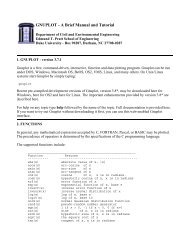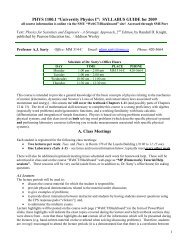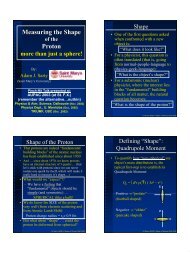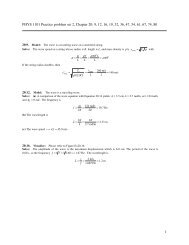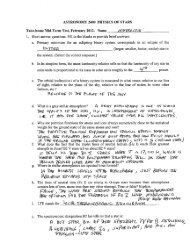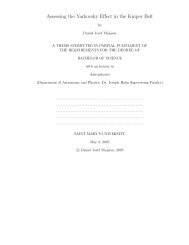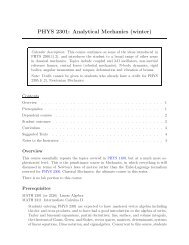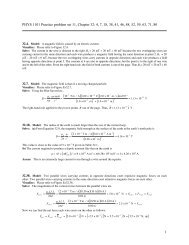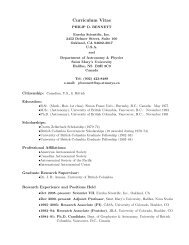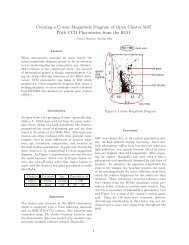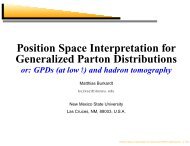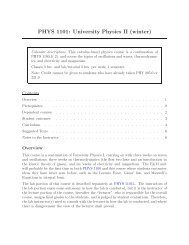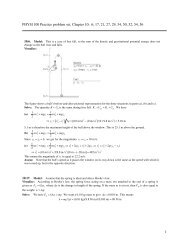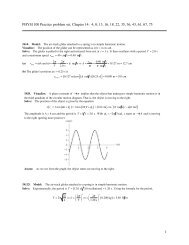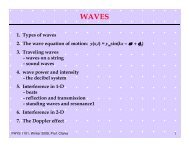Parity Radius Experiment (PReX)
Parity Radius Experiment (PReX)
Parity Radius Experiment (PReX)
You also want an ePaper? Increase the reach of your titles
YUMPU automatically turns print PDFs into web optimized ePapers that Google loves.
<strong>Parity</strong> <strong>Radius</strong> <strong>Experiment</strong><br />
208 Pb<br />
(<strong>PReX</strong> <strong>PReX</strong>)<br />
-- C. J. Horowitz, LOWq03, Halifax<br />
• Introduction: neutron<br />
skin of heavy nuclei.<br />
• <strong>Parity</strong> violation and<br />
neutron densities.<br />
• Implications for<br />
atomic physics,<br />
nuclear structure and<br />
neutron stars.
N. Star Crust vs Neutron Skin<br />
• Neutron star<br />
has solid crust<br />
over liquid<br />
core.<br />
• Heavy nucleus<br />
has neutron<br />
skin.<br />
Both neutron skin and solid<br />
crust are made out of neutron<br />
rich matter at similar densities.<br />
208Pb
Neutron Rich Skin<br />
• A heavy nucleus should have a neutron rich skin<br />
because of the neutron excess and coulomb<br />
barrier which removes protons from surface.<br />
• Thickness of skin depends on pressure of<br />
neutron rich matter as neutrons are pushed out<br />
against surface tension.<br />
• Measuring neutron rich skin with hadronic<br />
probes is difficult because of strong interaction<br />
uncertainties.
Weak Interaction Probes Neutrons<br />
• Z0 couples to weak charge which is weak<br />
isospin - 2sin2ΘW Qem. Add up weak<br />
charges of valence quarks:<br />
Qn=-1/2, Qp = ½-2sin2ΘW ≈ 0.<br />
• Weak charge of n À that of p.<br />
• <strong>Parity</strong> violating asymmetry in elastic<br />
electron scattering provides a purely<br />
electroweak probe of neutron density.
Jefferson Lab Hall A exp.<br />
• 850 MeV e elastically<br />
scattering at 6 deg.<br />
from 208Pb. • Goal: measure A ≈<br />
0.6 ppm to 3%. This<br />
gives neutron radius<br />
to 1% (± 0.05 Fm).<br />
• Cleanly resolves skin<br />
Rn-Rp≈ 0.2 Fm
Atomic <strong>Parity</strong> Nonconservation<br />
Low Energy Test of<br />
Standard Model<br />
• Depends on neutron densities.<br />
• Cs exp. good to 0.3% but<br />
limited by 1% atomic theory.<br />
• Not limited by R n but future<br />
0.1% exp would need R n to 1%<br />
• Future isotope ratio exp will<br />
need neutron radii differences.<br />
• Exp with Fr isotopes at RIA?<br />
Colorado Cs <strong>Experiment</strong><br />
• Combine neutron radii from<br />
PV e scattering with an atomic<br />
PNC exp for best low energy<br />
test of standard model.
R-process process nucleosynthesis<br />
• N=126 shell important for<br />
nucleosyn. Slow n<br />
capture reaches N=126<br />
at Z=82, Rapid n<br />
capture: N=126 with<br />
Z~66 (~ 192 Dy).<br />
• Red curves use rel. mean<br />
field force, green curves<br />
use nonrel. Skyrme force.<br />
Solid, 208 Pb, dashed,<br />
192 Dy.<br />
• Measurement in Pb<br />
constrains force and<br />
allows much better<br />
predictions for 192 Dy.<br />
Neutron density for N=126<br />
Oak Ridge calc.<br />
• R-process needs masses, n-capture and b-decay rates for n rich nuclei.
Liquid/Solid Transition Density<br />
• RPA stability against<br />
small amplitude density<br />
osc. Unstable if ε L
Observables Sensitive to Crust<br />
• Glitches in rotational period of pulsars from “starquakes”<br />
in solid crust. Vela crust must contain<br />
at least 1.4% of angular momentum. Crust can’t<br />
be too thin (ρ c or R can’t be too small).<br />
• Thermal properties depend on heat conduction<br />
through crust.<br />
• Solid crust can support nonaxial quadrupole<br />
deformations important for gravitational<br />
radiation. LIGO will look for signal at<br />
frequencies of known pulsars.<br />
• ...
Pb <strong>Parity</strong> <strong>Radius</strong> Exp. Status<br />
• Need septum magnets for spectrometers<br />
to view small angles. Being installed.<br />
• Need to demonstrate very good control<br />
over helicity correlated beam properties<br />
during Happex II and He experiments.<br />
[Note 3% goal would be world record].<br />
• Need to measure beam polarization to 2%<br />
or better, also QWeak needs pol. to 1%.
<strong>Parity</strong> <strong>Radius</strong> Measurement<br />
• Provides fundamental nuclear structure information<br />
because it can be both accurate and model independent.<br />
• Important for atomic parity tests of the standard model,<br />
nuclear structure including structure of very neutron rich<br />
nuclei, and astrophysics including neutron star<br />
properties: skin, radii, cooling...<br />
• Measurement is challenging but feasible.<br />
• Pb exp. is part of a robust JLAB parity program involving<br />
strange quark and standard model test measurements.<br />
• R n for Pb can help calibrate elastic p scattering and other<br />
strong probes. Measure matter densities of radioactive<br />
beams with p scattering.<br />
• Using parity to calibrate p scattering is like using β decay<br />
to calibrate (p,n).



